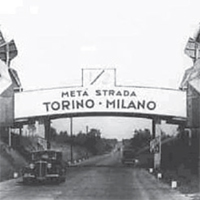Italy United... by the Infrastructures
Abstract
The events that led to the proclamation of the Reign of Italy in 1861, after the heroic actions by Garibaldi and the wise politics by Cavour, opened a new stage in Italian history. This is an important moment for a country that had always lived divisions among different political parties and had always been dominated by foreign rulers. The Italian state was created in an important historical period made of technical and economical development thanks to several technological inventions, such as textile machines, the train, the electrical telegraph. These inventions needed also a development in communications. Soon after the Unity of Italy the conditions of the last ones were considerably backward. From the physical geographical viewpoint, the distance between the two extremes of the peninsula, leaving out also the two main isles, was longer than that of all the other European Countries. Besides, just in the Po Valley and along few flat coast lines the relief conditions were suitable for building roads, railways and modern highways. Currently all that is clear: there a few stretches without flyovers, bridges, tunnels and viaducts, which have greatly contributed to transform the landscape (for example the link Genoa – Savona, belonging to highway Fiori – Genova/Ventimiglia – opened in 1967, includes 158 km built along the coast with 27 galleries and 90 viaducts). Historically the “entries of Italy” were the alpine passes and the ports on the coast. The “Belpaese” has been perhaps the most famous example of what the geographer Jean Gottmann called the “crossroads regions” (carrefours) with openings to the world which have given them great opportunities to connect and exchange. In the globalization age the new entries to the world are the international airports, while the telematic networks contribute to get rid of the idea of border itself. A journey to discover the thick and wide realization of communications and telecommunications works which, in different ways, have created “ the united and connected Italy”, with a huge effort being greater than the one of the other European Countries, for historical, geographical and urban planning reasons. Networks being fundamental not only for the economic growth and development, but also to build the national society and conscience.
Downloads
References
AA. VV. (2010), 1861/2011. Italia unita e diversa, Touring Club Italiano, Milano.
AA. VV. (1985) Italia. Ventesimo Secolo, Selezione dal Reader’s Digest, Milano.
Scirè G. (2008) Poste. Dal cavallo ad Internet, Giunti, Firenze.

Copyright (c) 2014 Tema. Journal of Land Use, Mobility and Environment

This work is licensed under a Creative Commons Attribution 4.0 International License.
Authors who publish in this journal agree to the following:
1. Authors retain the rights to their work and give in to the journal the right of first publication of the work simultaneously licensed under a Creative Commons License - Attribution that allows others to share the work indicating the authorship and the initial publication in this journal.
2. Authors can adhere to other agreements of non-exclusive license for the distribution of the published version of the work (ex. To deposit it in an institutional repository or to publish it in a monography), provided to indicate that the document was first published in this journal.
3. Authors can distribute their work online (ex. In institutional repositories or in their website) prior to and during the submission process, as it can lead to productive exchanges and it can increase the quotations of the published work (See The Effect of Open Access)
